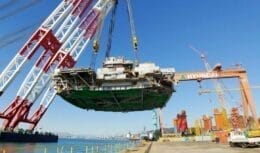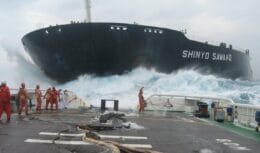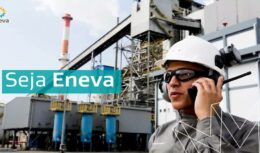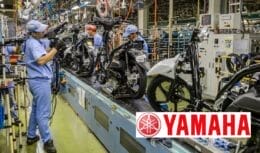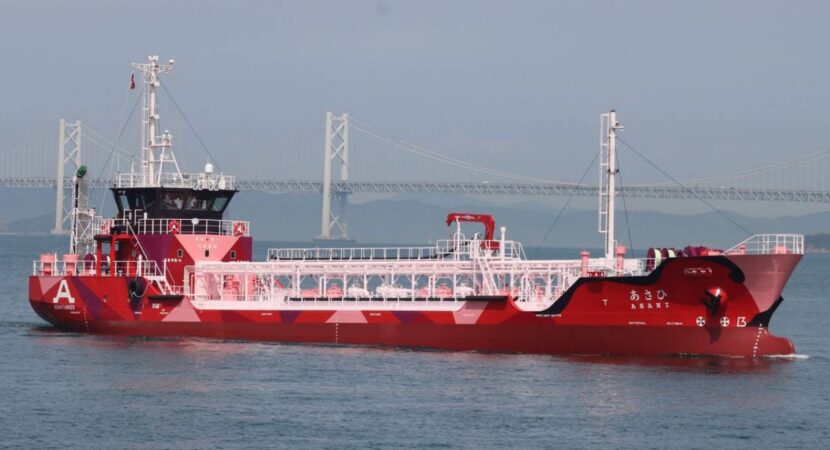
With capacity to transport 1.277 m3 of fuel, the first oil tanker powered by clean energy in the world was built at the Kawasaki shipbuilding yard
The world's first electric-powered tanker went into operation in last Wednesday in Japan, after several weeks of tests and demonstrations. The 492-ton tanker is powered entirely by large-capacity lithium-ion batteries, making it carbon-free in its operations. The ship Asahi operated by Asahi Tankers, is in commercial service but is also seen as a demonstration vessel contributing to the development of battery powered ships.
Watch the video below and check out the first tank ship powered entirely by electricity on the planet
The designs for the bunker ship were developed in cooperation with Japan's e5 Laboratory as part of its effort to develop zero-emission ships and through the use of technology to improve the working environment on board the ship. It was launched in December 2021 by Japanese shipbuilder Koa Sangyo and delivered to its owners Asahi Tankers on March 30.
The second electric-powered tanker in the world has already been ordered, will be built at the Zosen KK shipyard and should be delivered in March 2023.
Measuring 62 meters in length, the tanker has the capacity to transport 1.277 m 3 of fuel, providing fueling operations in Tokyo Bay. On April 26th, the Asahi powered the Mitsui OSK Line operated car transporter victorious ace at Daikoku Pier C-1 Wharf in Yokohama. According to the companies, this “marked a commemorative moment for the company's first bunkering operation. Asahi".
The vessel's energy is stored in a lithium-ion battery developed by Corvus Energy with the propulsion system built by Kawasaki. They reported that the battery has a capacity of 3.480 kWh, providing all the power needed for navigation, docking and cargo handling. The vessel is propelled by two 300kw azimuth thrusters and also has two 68kw side thrusters. The tanker has an operating speed of around 10 knots and a range of approximately 100 miles. It will take about 10 hours to fully recharge the batteries.
Since the delivery in late March, the ship has undergone power trials first at the shipyard and then at its newly built power plant in Kawasaki City. The specially designed plant refills the container. As part of the project developed by e5 and Kawasaki, the Asahi it can also serve as a power source designed to provide support in emergencies or natural disasters.
The ship drew large crowds of onlookers along with shipping industry officials who inspected her during her previews last week. In addition to zero-emission operations, Asahi reports that the tanker offers a more comfortable working environment with less noise and vibration than traditional vessels. They also hope there will be reduced requirements for engine maintenance.
Asahi contracted to build a second electrically powered bunker tank. The ship will be built at the Zosen KK shipyard and is expected to be delivered in March 2023.
MOL Group has now set a target of achieving net zero GHG emissions by 2050
O MOL Group has now set a target of achieving net zero GHG emissions by 2050 in the “MOL Group Environmental Vision 2.1”, announced in June 2021. The new vision is an update to the “MOL Group Environmental Vision 2.0”, announced in June 2020 The company analyzes scenarios, adopting the framework of the Task Force on Climate Related Financial Disclosures (TCFD). More specifically, the goals that MOL has set are:
- Deploy zero-emission liquid ocean vessels in the 2020s;
- Reduce the intensity of greenhouse gas emissions by approximately 45% by 2035 (versus 2019);
- With concerted effort across the Group, achieve net zero GHG emissions by 2050.
To achieve its goals, the company will pursue five initiatives to achieve medium and long-term goals. Through the five initiatives, it will work with industry partners to reduce its own GHG emissions and that of society. These initiatives are the following:
- Adoption of clean alternative fuels: Use of LNG, synthetic methane, ammonia, hydrogen as vessel fuel;
- Improved power saving technologies: Equipping vessels with the Wind Challenger system and introducing other new technologies;
- Increase operational efficiency: Reduction of fuel consumption through real-time monitoring of the ship's operational status;
- Building business models to enable net zero GHG emissions: active involvement in regulation and regulation, fair disclosure of emissions and the introduction of Internal Carbon Prices;
- Expansion of low carbon and decarbonization projects through the concentrated strengths of the MOL Group: Business development in the field of next generation fuels, such as offshore wind farm projects, hydrogen and ammonia.

